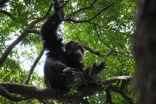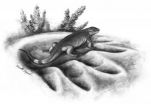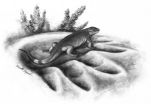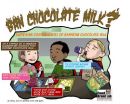(Press-News.org) Chimpanzees may select a certain type of wood, Ugandan Ironwood, over other options for its firm, stable, and resilient properties to make their bed, according to a study published April 16, 2014 in the open-access journal PLOS ONE by David Samson from the University of Nevada and Kevin Hunt from Indiana University.
Chimpanzees use tree branches to build beds or nests in trees. They select certain tree species to sleep in more frequently than other, but the reason for selecting a particular tree is unclear. To determine whether the physical properties of trees influenced nesting site selection, scientists measured the physical characteristics of wood from common tree species at the Toro-Semliki Wildlife Reserve, Uganda. They measured the stiffness and bending strength of 326 branches from the seven tree species most commonly used by the chimps. Additionally, they measured leaf surface area and determined the structure or architecture of each of the seven species.
Of 1,844 nests sampled, chimpanzees selected Ugandan Ironwood for 73.6% of the nests, even though it represented only 9.6% of all trees in the sample area. Ugandan ironwood was the stiffest and had the greatest bending strength of all the trees tested, had the smallest distance between leaves on the branches, and had the smallest leaf surface area. The authors suggest that chimpanzees select trees, like the Ugandan ironwood, due to these properties, as they may provide protection from predators and pathogens, as well as provide temperature regulation and comfort.
Dr. Samson added, "Chimpanzees, like humans, are highly selective when it comes to where they sleep. This suggests that for apes there is something inherently attractive about a comfortable bed--down to what kind of wood you use to make it."
INFORMATION:
Citation: Samson DR, Hunt KD (2014) Chimpanzees Preferentially Select Sleeping Platform Construction Tree Species with Biomechanical Properties that Yield Stable, Firm, but Compliant Nests. PLoS ONE 9(4): e95361. doi:10.1371/journal.pone.0095361
Financial Disclosure: National Science Foundation (SGER BNS 97-11124 and BCS 98-15991) and Indiana University (Faculty Research Support Program and the College of Arts and Sciences. The funders had no role in study design, data collection and analysis, decision to publish, or preparation of the manuscript.
Competing Interest Statement: The authors have declared that no competing interests exist.
PLEASE LINK TO THE SCIENTIFIC ARTICLE IN ONLINE VERSIONS OF YOUR REPORT (URL goes live after the embargo ends): http://dx.plos.org/10.1371/journal.pone.0095361
Chimpanzees prefer firm, stable beds
Chimps select tree branches for stable, comfortable, safe beds
2014-04-17
ELSE PRESS RELEASES FROM THIS DATE:
In funk music, rhythmic complexity influences dancing desire
2014-04-17
Rhythmic drum patterns with a balance of rhythmic predictability and complexity may influence our desire to dance and enjoy the music, according to a study published April 16, 2014 in the open-access journal PLOS ONE by Maria Witek from University of Oxford and colleagues from Aarhus University, Denmark and Oxford University.
Many people find themselves unable to resist moving their bodies to the thumping beat of hip-hop, electronic, or funk music, but may feel less desire to dance when listening to a highly syncopated type of music, like free jazz. Researchers interested ...
New species discovery sheds light on herbivore evolution
2014-04-17
A new fossil may provide evidence that large caseid herbivores, the largest known terrestrial vertebrates of their time, evolved from small non-herbivorous members of that group, according to a study published April 16, 2014 in the open-access journal PLOS ONE by Robert Reisz from University of Toronto and Jörg Fröbisch of the Museum für Naturkunde.
The origin and early evolution of vertebrates living on land led to major changes in the structure of terrestrial ecosystems. The first appearance of herbivores played a pivotal role in this transformation, and a newly discovered ...
Research may help doctors predict who gets long-term complications from Lyme disease
2014-04-17
A team of scientists led by Johns Hopkins and Stanford University researchers has laid the groundwork for understanding how variations in immune responses to Lyme disease can contribute to the many different outcomes of this bacterial infection seen in individual patients. A report on the work appears online April 16 in PLOS One.
"Physicians have recognized for many years that Lyme disease is not a uniform disease process and can vary in outcomes," says Mark Soloski, Ph.D., a professor of medicine at the Johns Hopkins University School of Medicine and senior author of ...
Off-season doesn't allow brain to recover from football hits, study says
2014-04-17
Six months off may not be long enough for the brains of football players to completely heal after a single season, putting them at even greater risk of head injury the next season.
"I don't want to be an alarmist, but this is something to be concerned about," said Jeffrey J. Bazarian, M.D., associate professor of Emergency Medicine at the University of Rochester School of Medicine and Dentistry and lead author of the study, published in PLOS ONE.
"At this point we don't know the implications, but there is a valid concern that six months of no-contact rest may not be enough ...
Earliest ancestor of land herbivores discovered
2014-04-17
New research from the University of Toronto Mississauga demonstrates how carnivores transitioned into herbivores for the first time on land.
"The evolution of herbivory was revolutionary to life on land because it meant terrestrial vertebrates could directly access the vast resources provided by terrestrial plants," says paleontologist Robert Reisz, a professor in the Department of Biology. "These herbivores in turn became a major food resource for large land predators."
Previously unknown, the 300-million-year old fossilized juvenile skeleton of Eocasea martini is ...
Banning chocolate milk backfires
2014-04-17
ITHACA, N.Y. – To some, banning chocolate milk from elementary schools seemed like a good idea, but new Cornell University research shows that removing chocolate milk from school menus has negative consequences.
"When schools ban chocolate milk, we found it usually backfires. On average, milk sales drop by 10 percent, 29 percent of white milk gets thrown out, and participation in the school lunch program may also decrease," reports Andrew Hanks, lead author and research associate Cornell's Dyson School of Applied Economics and Management. "This is probably not what parents ...
Researchers see hospitalization records as additional tool
2014-04-17
MEDFORD/SOMERVILLE, Mass. – Comparing hospitalization records with data reported to local boards of health presents a more accurate way to monitor how well communities track disease outbreaks, according to a paper published April 16 in the journal PLOS ONE by a research team led by Elena Naumova, Ph.D., professor of civil and environmental engineering and associate dean at Tufts University School of Engineering.
In a paper titled "Hospitalization Records as a Tool for Evaluating Performance of Food and Water-Borne Disease Surveillance Systems: A Massachusetts Case Study," ...
The surprising consequences of banning chocolate milk
2014-04-17
VIDEO:
Director of the Cornell Food and Brand Lab, Brian Wansink recommends, "There are other ways to encourage kids to select white milk without banning the chocolate. Make white milk appear...
Click here for more information.
For many children eating school lunch, chocolate milk is a favorite choice. What would happen if chocolate milk were banned from school cafeterias? "Students take 10% less milk, waste 29% more and may even stop eating school meals," says Andrew Hanks, ...
Family ties in the language jungle
2014-04-17
This news release is available in German. The only linguistic data available for Carabayo, a language spoken by an indigenous group that lives in voluntary isolation, is a set of about 50 words. This list was compiled in 1969 during a brief encounter with one Carabayo family. Frank Seifart of the Max Planck Institute for Evolutionary Anthropology in Leipzig, Germany, and Juan Alvaro Echeverri of the Universidad Nacional de Colombia in Leticia, Colombia, have now analysed this historical data set and compared it with various languages (once) spoken in the region. The ...
High disease load reduces mortality of children
2014-04-17
This news release is available in German. Children who have been conceived during a severe epidemic are more resistant against other pathogens later in life. For the first time this has been proved by researchers at the Max Planck Institute for Demographic Research (MPIDR) in Rostock, Germany, for the 18th century epidemics of measles and smallpox in the Canadian province of Québec. Children who were conceived during the wave of measles in 1714 and 1715 died significantly less often from smallpox 15 years later than children who had been conceived before the measles ...
LAST 30 PRESS RELEASES:
Black women hospitalised in USA with blood infection resistant to last-resort antibiotic at increased risk of death
NEC Society Statement on the Watson vs. Mead Johnson Verdict
Lemur’s lament: When one vulnerable species stalks another
Surf clams off the coast of Virginia reappear – and rebound
Studying optimization for neuromorphic imaging and digital twins
ORNL researchers win Best Paper award for nickel-based alloy tailoring
New beta-decay measurements in mirror nuclei pin down the weak nuclear force
Study uncovers neural mechanisms underlying foraging behavior in freely moving animals
Gene therapy is halting cancer. Can it work against brain tumors?
New copper-catalyzed C-H activation strategy from Scripps Research
New compound from blessed thistle promotes functional nerve regeneration
Auburn’s McCrary Institute, ORNL to partner on first regional cybersecurity center to protect the nation’s electricity grid
New UNC-Chapel Hill study examines the increased adoption of they/them pronouns
Groundbreaking study reveals potential diagnostic marker for multiple sclerosis years before symptom onset
Annals of Internal Medicine presents breaking scientific news at ACP’s Internal Medicine Meeting 2024
Scientists discover new way to extract cosmological information from galaxy surveys
Shoe technology reduces risk of diabetic foot ulcers
URI-led team finds direct evidence of ‘itinerant breeding’ in East Coast shorebird species
Wayne State researcher aims to improve coding peer review practices
Researchers develop a new way to safely boost immune cells to fight cancer
Compact quantum light processing
Toxic chemicals from microplastics can be absorbed through skin
New research defines specific genomic changes associated with the transmissibility of the monkeypox virus
Registration of biological pest control products exceeds that of agrochemicals in Brazil
How reflecting on gratitude received from family can make you a better leader
Wearable technology assesses surgeons’ posture during surgery
AATS and CRF® partner on New York Valves: The structural heart summit
Postpartum breast cancer and survival in women with germline BRCA pathogenic variants
Self-administered acupressure for probable knee osteoarthritis in middle-aged and older adults
2024 Communicator Award goes to “Cyber and the City” research team based in Tübingen
[Press-News.org] Chimpanzees prefer firm, stable bedsChimps select tree branches for stable, comfortable, safe beds





